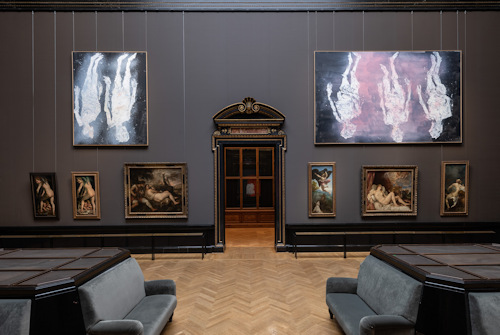
It’s one thing to have an exhibition of works by a giant of contemporary art. Now imagine that same giant acts as co-curator. The result is the Baselitz. Naked Masters exhibition at the Kunsthistorisches Museum (KHM).
- Baselitz in dialogue with Old Masters
- Focuses on the naked human form
- Also includes his recent art
- Builds bridges across time
- Runs Mar 7 – Jun 25, 2023
- See also
- KHM overview & visitor tips
- Art exhibitions in Vienna
Naked Masters

(Baselitz. Naked Masters. Exhibition view © KHM-Museumsverband)
Georg Baselitz remains one of the most influential and important artists of modern times.
Painter, sculptor, printmaker, set designer. A Chevalier de la Légion d’Honneur. A man with past solo exhibitions in such prestigious locations as New York’s Guggenheim Museum, London’s Royal Academy or the Centre Pompidou in Paris. And, of course, the undisputed master of the upside-down motif.
In the Naked Masters exhibition, Baselitz places his own works in dialogue with those of such historical masters of their craft as Titian, Rubens, Cranach, or Parmigianino.
The German-born artist picked out over 70 of his paintings (plus a couple of sculptures) to place alongside some 40 works from the Kunsthistorisches Museum’s own picture gallery.
The juxtaposition largely reflects visual parallels and has a clear focus on the naked form (hence the exhibition title).
While the painters of the past portrayed mythological scenes and religious imagery, Baselitz offers a keener eye on the essential human condition that is nudity per se. Though the two approaches are not entirely distinct; Baselitz has always built his body of work with a strong awareness of what went before.

(Baselitz. Naked Masters. Exhibition view © KHM-Museumsverband)
The integration seems remarkable, despite the centuries between works observable in techniques and colour.
The overall impression is certainly helped by the absence of any notable exhibition text on walls, for example. Instead, paintings and explanatory information are presented much as elsewhere in the picture gallery.
Already in the first room, five of Baselitz’s 2019 paintings of hands form a half-ring around Garofalo’s early 16th-century The Resurrection of Christ, thus exuding the feel of galleries of old, where paintings filled the wall space like a solitaire puzzle.
Some juxtapositions reveal an uncanny resemblance. For example, Baselitz’s 1998 Persian Loves I seems like an almost reverse negative (albeit turned through 90°) of the neighbouring Venus and Adonis painted by Bartholomeus Spranger at the end of the 1500s.
The outcome for the viewer is manifold.
You have a look at Baselitz’s oeuvre across several decades (including some newer works), with its various nuances and artistic evolution. But you also gain new perspectives on the Old Masters, where the focus moves away from the story into composition, aesthetics and ambience.
Dates, tickets & tips
Enjoy Baselitz’s body of art and the art of bodies from March 7th to June 25th, 2023. A ticket from or for the Kunsthistorisches Museum includes the special exhibitions within.
Vienna is enjoying a rich Baselitz era at the moment. For example, he created an original work for a charity auction at the 2023 Vienna Opernball that went for almost double its reserve price.
And we have key exhibitions showcasing relevant works at other institutions. For example:
- Several prints by Baselitz feature in the Albertina Modern’s Andy Warhol to Damien Hirst exhibition (runs concurrently with Naked Masters)
- A solo exhibition of Baselitz’s drawings takes place at the Albertina (from June 7th, 2023)
How to get to Baselitz
Follow the travel tips at the bottom of the Kunsthistorisches Museum article. Go up to the picture gallery floor to find the exhibition.
Address: Burgring 7, 1010 Vienna
(Article icon courtesy of the Met Museum.)